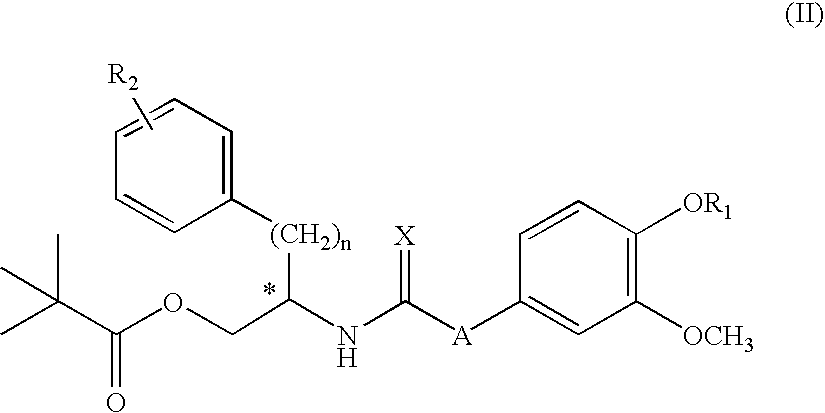Simplified resiniferatoxin analogues as vanilloid receptor agonist showing excellent analgesic activity and the pharmaceutical compositions containing the same
a vanilloid receptor and resiniferatoxin technology, applied in the field of vanilloid analogues containing resiniferatoxin pharmacophores, can solve the problems of limited availability from natural sources, narrow therapeutic index, intrinsic lower potency and therapeutic index of cap-like analogues, etc., and achieve the effect of reducing pain
- Summary
- Abstract
- Description
- Claims
- Application Information
AI Technical Summary
Benefits of technology
Problems solved by technology
Method used
Image
Examples
example 1
Preparation of 2-(3,4-dimethylphenyl)acetonitrile (2)
A mixture solution of 3,4-dimethylbenzyl chloride 10 g (64.7 mmol) in dimethyl formamide (15 ml) was treated with sodium cyanide (15.85 g, 323.8 mmol) for 16 hrs at 100° C. The mixture was diluted with H2O and extracted with CH2Cl2 several times. The combined organic layers were washed with H2O, dried over MgSO4, and concentrated in vacuo. The residue was purified by flash column chromatography on silica gel with EtOAc / hexanes (1:10) as an eluant to give compound 2.
100% yield, colorless oil. 1H-NMR (CDCl3) δ: 6.95-7.25 (m, 5 H), 3.60 (s, 2 H, CH2CN), 2.25 (d, 3 H, J=12.9 Hz, CH3), 2.20 (d, 3 H, J=12.9 Hz, CH3).
example 2
Preparation of methyl-2-(3,4-dimethylphenyl)acetate (4)
A mixture solution of 2-(3,4-dimethylphenyl)acetonitrile (2) (9.395 g, 64.7 mmol) in methanol was refluxed with H2SO4 3.5 ml (64.7 mmol) for 3 days. The mixture was cooled, diluted with H2O and concentrated in vacuo under sodium bicarbonate. The residue was separated H2O and CH2Cl2 and the H2O layer was extracted with CH2Cl2 several times. The combined organic layers were washed with H2O, dried over MgSO4, and concentrated in vacuo. The residue was purified by flash column chromatography on silica gel with EtOAc / hexanes (1:10) as an eluant to give compound 4.
98% yield, yellow oil. 1H-NMR (CDCl3) δ: 6.95-7.1 (m, 5 H), 3.66 (s, 3 H, CO2CH3), 3.54 (s, 2 H, CH2CO2), 2.25 (d, 3 H, J=13.4 Hz, CH3), 2.20 (d, 3 H, J=9.8 Hz, CH3).
example 3
Preparation of 2-(3,4-dimethylphenyl)1-ethanol (6)
A cooled solution of lithium aluminium hydride (4.8 g, 126.6 mmol) in diethyl ether at 10° C. was treated dropwise with a solution of methyl-2-(3,4-dimethylphenyl)acetate(4). After stirring for 3 hrs at room temperature, the reaction mixture was stirred for 30 min at room temperature, cooled in ice-bath and stirred for 1 hr at room temperature by the dropwise addition of H2O 5 ml, NaOH 10 ml and H2O 15 ml. The mixture was filtered and washed with EtOAc and the filtrate was concentrated in vacuo. The residue was purified by flash column chromatography on silica gel with EtOAc / hexanes (1:3) as an eluant to give compound 6.
60% yield, colorless oil. 1H-NMR (CDCl3) δ: 6.95-7.1 (m, 5 H), 3.85 (m, 2 H, CH2OH), 2.81 (t, 2 H, J=6.6 Hz, CH2Ar), 2.25 (m, 6 H, 2×CH3).
PUM
| Property | Measurement | Unit |
|---|---|---|
| Mass | aaaaa | aaaaa |
| Mass | aaaaa | aaaaa |
| Mass | aaaaa | aaaaa |
Abstract
Description
Claims
Application Information
 Login to View More
Login to View More - R&D
- Intellectual Property
- Life Sciences
- Materials
- Tech Scout
- Unparalleled Data Quality
- Higher Quality Content
- 60% Fewer Hallucinations
Browse by: Latest US Patents, China's latest patents, Technical Efficacy Thesaurus, Application Domain, Technology Topic, Popular Technical Reports.
© 2025 PatSnap. All rights reserved.Legal|Privacy policy|Modern Slavery Act Transparency Statement|Sitemap|About US| Contact US: help@patsnap.com



